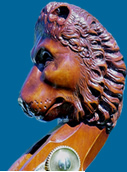|
|
|
|
|
|
LUTHIER
RANT
Fingerboards
| Bass Bars | Glues
| Saddles | Bridges
My Tuners | The
Sound Post | Regraduation
|
BRIDGES — which adjusters? Years ago I used to wonder what a bass would sound like with a solid bridge. Every bass I worked on had to have wood adjusters put in without exception. It just seemed to me that a solid bridge would sound better. Finally, when I made my first bass I decided to try a solid bridge. I was very happy with the sound - but of course that didn't tell me anything conclusive about Solid vs. Adjustable. When the season changed I needed to either cut a second bridge or install adjusters. I realized that putting in adjusters would be a pretty darn good scientific experiment - I was very familiar with my own bass. So I put them in and I could tell absolutely no difference. Now that just sez that I couldn't tell - somebody else might. Over the years I heard many different opinions - both pro and con from all types of players. I eventually came to the opinion that the pros of adjusters outweigh the cons. But what material to use? I consulted John Schaeffer [ex-NY Phil principal] on the matter. If anyone knows tone - he does. John claimed that anyone saying they could hear the difference between wood and aluminum adjusters was, well, I think he might have said they were in error. That was good enough for me. I started making my own out of aluminum. This material offers several major advantages over wood. Traditionally, adjusters are made from two parts - a shaft and a disk. These are affixed together. The two parts can separate under use - sometimes with catastrophic results. This happens quite frequently with wooden adjusters [with the exception of the ones made by Stenholm - distributed by Robertson. Works of art!]. Most wooden adjusters are poorly made third world imports. In addition, the nature of using two pieces makes it very difficult to make the disk line up exactly at 90 degrees to the shaft. This is crucial to fluid use. Lastly, because of the difficulty of threading the wood shaft, the shaft itself must have a large diameter. This causes it to occupy a large portion of the bridge leg diameter, often resulting in cracked legs. My adjusters are one piece, machined from a solid cylinder of aluminum. This eliminates all possibility of breakage. It also insures that the horizontal and vertical are precisely at 90 degrees. Because the threads on the aluminum don't break like the wood, the shaft can be much thinner-virtually eliminating the chance of cracking the bridge leg. I also make the disk part greater in diameter than is usually seen in order to ease the turning. They rule! I never claim to be an expert on tone, so I won't go out on a limb and say what sounds better - aluminum/wood/solid. But I do know structure and solid aluminum beats wood hands down. Fortunately sound structure seems to be a component of good tone. page | 1 | |


| 359 Miller Avenue, Freeport, NY 11520 (516) 867 1395 · jbollbach17@gmail.com |